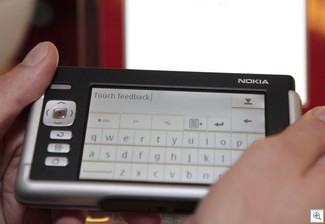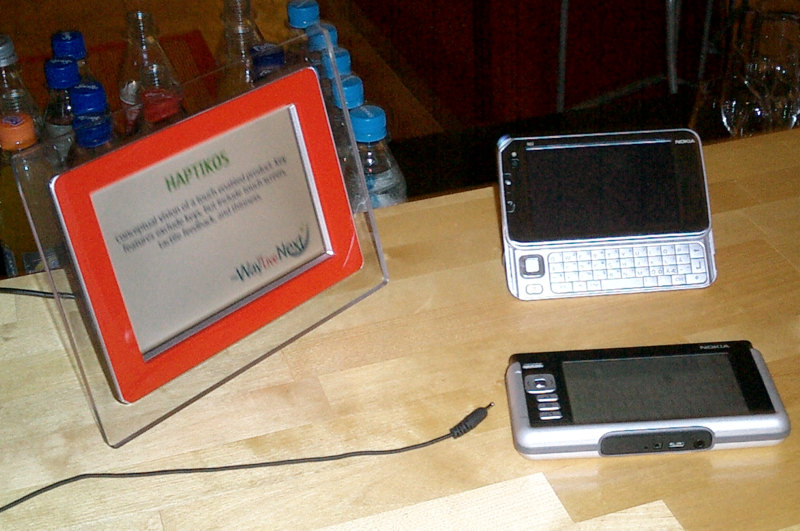
The Sony Ericsson V640i is a Vodafone exclusive mid-range 3G candybar music phone. Available in Havana Gold or Quick Black, the V640i boasts similar features to other mid-range 3G Sony Ericsson phones, such as the K530i and W660i.
The V640i gets a few extra bonus points over other mid-range 3G mobile. There's HSDPA - up to 4 times faster Internet downloads than 3G, 4 GB memory card support and there's Sony Ericsson's new Media Manager software. The V640i is also quad-band - get better coverage in USA, Australia, Canada and many South American countries.
The camera isn't a full-feature job, there's no flash or autofocus and the screen resolution is just 176 x 220 pixels (same as other mid-range phones). A 240 x 320 screen resolution would have been better, although the price would likely be increased a little.
Design
Sony Ericsson 3G candybar phones are much alike. Similar weights, similar dimensions, keyboard layouts and features. The V630i follows the same format. Made of plastic, video camera on the front (top right), volume and camera buttons on the right, connector on the bottom, and memory card slot on the left.
Keypad: The keys are oblong, big enough, and have decent spacing. The circular navigation keys are a good size - the confirmation key is big.
The memory card slot supports up to a 4 GB Memory Stick Micro (M2) card - you can get one of them for about £30 at Amazon.co.uk.
The loudspeaker is the circle beneath the camera lens on the back. Sounds OK.
Music Player
Walkman Player 2.0. The music player supports MP3, WMA, AAC, AAC+ and eAAC file formats. View album covers, titles, browse by artists, tracks, playlists, visualization, play mode, skins, stereo widening, equalizer, loop and shuffle.
The V640i has trackID - the music recognition service, PlayNow and numerous quick links to Vodafone Live's music download service (I call them the 'money links').
Media Manager
Organise music, photos, video clips and podcasts on your PC, then transfer them to your phone. An improvement over Disc2phone software. If you lose your CD, download Media Manager from the Sony Ericsson Web site. Or download it right now to have a look.
HSDPA = Fast Internet Downloads
HSDPA stands for High-speed download packet access. The V640i press release states "... can download a track in 14 seconds". Vodafone lead the way in HSDPA mobile broadband services. Current theoretical peak speeds are "up to 3.2 Mbps". You're more likely to get speeds up to 1.4 Mbps (that's what the Vodafone Web site says) - at least 4 times faster than 3G (384 Kbps).
3G is an 'always-on' connection. Much like your home broadband connection, voice and data can be transmitted simultaneously. Yep, use data and voice at the same time - download the latest music tracks whilst you're on the phone chatting to granny Gertrude.
The V640i also has EDGE support (2.75G). At the time of writing (November 2007), EDGE isn't very widespread. EDGE is also quite slow - ask an Apple iPhone user about it. Hahahahahahahahah...
Web browsing
Speed wise, the Sony Ericsson V640i is very good. The browser is fine. Combined with fast download speeds, the V640i is fine for downloading music from online services and getting snippets of information.
Google Maps, eBay, Accuweather
The V640i has a few goodies pre-installed.
* Google Maps - useful. If you want GPS, the V640i supports the GPS enabler HGE-100 headset. Just plug the GPS headset into the V640i connector.
* eBay - a great place to buy hot mobile phones.
* Accuweather - Get weather reports for any city.
2 MP Camera
The V640i is a music-focussed phone. The camera is basic. There's no autofocus, flash, macro mode or mirror. The images are OK (very subjective - you might think they're crappy or you might think they're the best thing since Sooty).
They don't look great compared to top-end camera phones - K850i for example. Pretty obvious.
Identical options to other mid-range 3G Sony Ericsson phones. Shoot mode, picture size, night mode, self-timer, effects, white balance, shutter sound, picture quality, save settings and a few more. 2 megapixels is 1600 x 1200 pixels. Video capture is 176 x 144 (QCIF).
Other Fun V640i Features
FM radio with RDS, Video, Music and Photo DJ, 3G video calling (there's a front-facing video call camera), Blueooth, USB, USB mass storage, and a very good 9 hours 2G talk-time.
Summary
The V640i is a Vodafone exclusive handset. The V640i is great for music playing - 4 GB memory card support is good. HSDPA and quad-band earns the V640i more bonus marks. You can buy the V640i on contract, not sure about on PAYG or SIM free.
FEATURES
- 103 x 47 x 15 mm, 97 g
- Talk time (9 hours), Standby time (300 hours)
- 2-inch 176 x 220 pixel, 262k colour screen
- 32 MB phone memory, Memory Stick Micro M2 (up to 4 GB)
- Quad-band (850, 900, 1800 and 1900 Mhz)
- EDGE, 3G, HSDPA, Bluetooth, USB
- 2 MP camera, video capture
- SMS, MMS, Email
- Video calling, video call camera
- Media player, TrackID, PlayNow, RDS FM radio
- Media manager
- Access NetFront Web browser, RSS feeds
- Sound recorder, voice dialling, voice control
- Organizer tools
In The Box
Sony Ericsson V640i, battery, charger, USB cable, headset, 256 MB memory card, software CD, user guide. Buy the Sony Ericsson V640i
Cheap Sony Ericsson V640i contract deals, offers, free gifts and promotions.
read more |
digg story






































